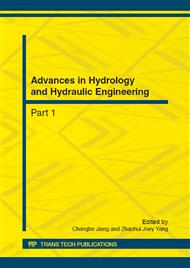p.1131
p.1136
p.1141
p.1147
p.1151
p.1155
p.1161
p.1168
p.1172
Effects of Water Temperature on Clinging Flow of Rectangular Sharp-Crested Weir
Abstract:
Surface tension associated with temperature is usually considered non-negligible to affect discharge capacity of sharp-crested weir when head is low. In the study, a two-dimensional numerical model verified by experiments was applied to simulate the effect of water temperature on discharge capacity of clinging flow for a rectangular sharp-crested weir at low head levels. The results showed that with a same flow rate, differences in the elevation of free surface were minimal between different temperature levels despite a slightly higher elevation of free surface at lower water temperature. The head-discharge relationships were very similar for different temperature levels. This study concluded that the effect of water temperature on head-discharge relationships and the discharge capacity of clinging flow for a rectangular sharp-crested weir was negligible at low heads.
Info:
Periodical:
Pages:
1151-1154
Citation:
Online since:
October 2012
Authors:
Price:
Сopyright:
© 2012 Trans Tech Publications Ltd. All Rights Reserved
Share:
Citation:


